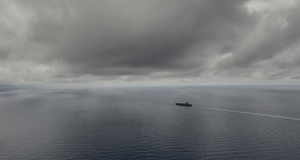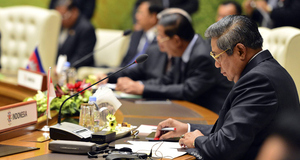Featured Article:Globalization's Peace: The Impact of Economic Connections on State Aggression and Systemic Conflict
By
2012, Vol. 4 No. 08 | pg. 3/3 | « ConclusionThis study has extended the logic of the liberal perspective to present a theory that treats states’ economic connections and aggressive tendencies as monadic. The reasoning behind this is that, in theory, any state that relies heavily on foreign trade or investment should be reluctant to risk offending its economic partners—and thus its prosperity—by initiating conflict. As detailed above, this model is effective for predicting state and overall systemic aggression. However, the model is by no means flawless; like any theory, it is a simplified version of reality, and its limitations are discussed below. But in spite of these, I am confident enough in these findings to be optimistic; if international economic connections continue to proliferate, international conflict is likely to decline. LimitationsThe first limitation of this study’s model is that it does not take into account the possibility that a state’s trading partners might approve or even encourage an act of aggression. In this regard, the model is inadequate. However, in my view its logic, if not always its conclusions, will hold in most cases—the “norm of nonaggression” is such that states’ trading partners will not be permissive of aggressive acts in most cases.7 This is a question that should prove extremely fruitful for future research; however, it is beyond the scope of this study, and I leave it to be considered by scholars in the future. Second, there is an unsolved problem of causation. It is possible that international cooperation may cause interconnectedness rather than vice-versa—what Kim and Rousseau (2005) call “the simultaneity problem.” This difficulty is endemic in the social sciences, and at present this model cannot with certitude overcome it. However, the mere fact that trade is associated with peace is reason to favor and promote it; while it may or may not be the root cause of decreased conflict, it is at least clear enough that trade is not detrimental to peace.Third and finally, the model does not adequately measure the composition of trade. Some goods could potentially be seen by the recipient country as more important than others. As Oneal et al (1996, p. 16) note: “A country that imports large quantities of oil…may feel greater vulnerability” than one that imports bananas. For the purposes of the model, a heightened sense of vulnerability could make that state more reluctant to initiate aggression. However, on the whole the “importance” of a traded good should be reflected in its price, and thus should be for the most part adequately measured by this study’s use of imports and exports as percentages of GDP. Thus, while this model does not address all facets of the economic connections’ impact on aggression, the model is at least useful for further research on the matter, as unanswered concerns and remaining questions left by this nascent model will surely provide fodder for future research questions. This, it can be hoped, will be this research’s greatest contribution to the scholarship on interstate peace and war. Future ProspectsThis study has found that systemic conflict and aggression are dampened by interstate economic connections, and that individual states’ capacity for aggression is weakened by a high reliance on trade. The lesson of these findings is clear: if states seek to secure enduring peace and pacify their neighbors, they should encourage trade with all possible persistence. Even though higher amounts of FDI inward and outward are seen to be associated with more state aggression, these findings give reason to have a cautious sense of optimism as the world moves forward in an era of increased economic interconnectedness. If the future is to be defined by globalization, then, as indicated in this research, the future may be defined by greater global cooperation and relative peace. ReferencesBarbieri, Katherine. 2002. The Liberal Illusion: Does Trade Promote Peace? Ann Arbor: University of Michigan Press. Barbieri, Katherine. 1996. Economic Interdependence: A Path to Peace or a Source of Interstate Conflict? Journal of Peace Research 33 (1): 29-49. Buzan, Barry. 1984. Economic Structure and International Security: The Limits of the Liberal Case. International Organization 38 (4): 597-624. Clinton, Bill. 1993. Remarks on the Signing of NAFTA. December 8. http://millercenter.org/scripps/archive/speeches/detail/3927 (May 23, 2011). Crescenzi, Mark J. C. 2005. Economic Interdependence and Conflict in World Politics. Lanham, MD: Lexington. Crescenzi, Mark J. C. 2003. Economic Exit, Interdependence, and Conflict. The Journal of Politics 65 (3): 809-832. De Vries, Michael S. 1990. Interdependence, Cooperation, and Conflict: An Empirical Analysis. Journal of Peace Research 27 (4): 429-444. Ferguson, Niall. 2005. Sinking Globalization. Foreign Affairs 84 (2): 64-77. Gasiorowski, Mark J. 1986. Economic Interdependence and International Conflict: Some Cross-National Evidence. International Studies Quarterly 30 (1): 23-38. Ghosn, Faten, and Scott Bennett. 2007. Codebook for the Dyadic Militarized Interstate Incident Data, Version 3.10. Online: http://correlatesofwar.org. Hegre, Havard. 2004. Size Asymmetry, Trade, and Militarized Conflict. The Journal of Conflict Resolution 48 (3): 403-429. Kim, Hyung Min, and David L. Rousseau. 2005. The Classic Liberals Were Half-Right (or Half-Wrong): New Tests of the “Liberal Peace,” 1960-88. Journal of Peace Research 42 (5): 523-543. Maoz, Zeev. 2009. The Effects of Strategic and Economic Interdependence on International Conflict Across Levels of Analysis. American Journal of Political Science 53 (1): 223-240. McMillan, Susan M. 1997. Interdependence and Conflict. Mershon International Studies Review 41 (1): 33-58. Mearsheimer, John J. 2001. The Tragedy of Great Power Politics. New York: W.W. Norton. Millen, Joyce V., and Timothy H. Holtz. 2000. Dying for Growth, Part I: Transnational Corporations and the Health of the Poor. In Dying for Growth: Global Inequality and the Health of the Poor, eds. Jim Yong Kim et al. Monroe, ME: Common Courage Press, 187-201. Morgenthau, Hans J. [1948] 1985. Politics Among Nations: The Struggle for Power and Peace. New York: Alfred A. Knopf. Nau, Henry R. 2009. Perspectives on International Relations: Power, Institutions, and Ideas. Washington: CQ Press. Oneal, John R, Frances H. Oneal, Zeev Maoz, and Bruce Russett. 1996. The Liberal Peace: Interdependence, Democracy, and International Conflict, 1950-85. Journal of Peace Research 33 (1): 11-28. Heston, Alan, Robert Summers, and Bettina Aten. 2011. Penn World Table Version 7.0, Center for International Comparisons of Production, Income and Prices at the University of Pennsylvania. Stiglitz, Joseph E. 2002. Globalism’s Discontents. The American Prospect 13 (1): A16-A21. United Nations Conference on Trade and Development. 2010. Inward and outward foreign direct investment flows, annual, 1970-2009. UnctadStat. http://unctadstat.unctad.org/TableViewer/tableView.aspx?ReportId=88 (May 23, 2011). Waltz, Kenneth N. 1979. Theory of International Politics. Boston: McGraw-Hill. World Bank. 2011. Exports of Goods and Services (% of GDP). World Development Indicators, 2011. http://data.worldbank.org/indicator/NE.EXP.GNFS.ZS (May 23, 2011). World Bank. 2011. Imports of Goods and Services (% of GDP). World Development Indicators, 2011. http://data.worldbank.org/indicator/NE.IMP.GNFS.ZS (May 23, 2011). Endnotes 1.) American President Bill Clinton (1993), for example, made the connection between “a greater possibility of world peace” and international trade in his justification for the North American Free Trade Agreement. 2.) See Kim and Rousseau (2005), Barbieri (2002), Barbieri (1996), Hegre (2004), de Vries (1990), Crescenzi (2005), Crescenzi (2003), Oneal et al. (1996). 3.) See Maoz (2009) and Gasiorowski (1986). 4.) Complete set of contingency and data tables available upon request. 5.) The Gamma statistic measures ordinal variable correlation from -1.0 to 1.0. An absolute value of 1.0 indicates a perfect relationship between variables (either negative or positive), a value of 0 indicates no relationship, and a negative value indicates that the variables have a negative relationship. 6.) The Pearson’s r correlation coefficient measures the strength of association between interval variables, using values from -1.0 to 1.0. An absolute value of 1.0 indicates a perfect relationship between the variables (either negative or positive), a value of 0 indicates no relationship, and a negative value indicates that the variables have a negative relationship. Regression values indicate how many units the dependent variable changes by when the independent variable increases by one unit. 7.) See, for example, the U.S. invasion of Iraq in 2003, as great controversy was aroused over the attack. But given the U.S.’s relatively low levels of imports and exports compared to its GDP, the model’s case is all the more strengthened. Suggested Reading from Inquiries Journal
Inquiries Journal provides undergraduate and graduate students around the world a platform for the wide dissemination of academic work over a range of core disciplines. Representing the work of students from hundreds of institutions around the globe, Inquiries Journal's large database of academic articles is completely free. Learn more | Blog | Submit Latest in Political Science |


















